In the Footsteps of Mary MacKillop
November 8, 2020For the past twenty-five years, the Sisters of Saint Joseph have invited people to participate in the ‘Australian National Pilgrimage: In the Footsteps of Mary MacKillop.’
Unfortunately they have not been able to offer this opportunity of journeying with Mary in 2020.
Mary reminds us that ‘We are but travellers here.’
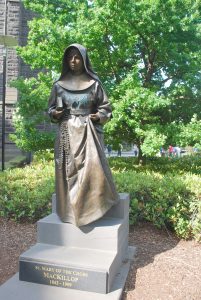
You are invited to read and reflect on the following article ‘St Mary MacKillop – The Pilgrim’, written by Mary Cresp rsj.
The theme of journey was never far from the thoughts of Mary MacKillop.
As the words printed around her tomb remind us, she saw life as a journey. Remember we are but travellers here, she said. The many journeys that made up her life were both actual and metaphorical. Perhaps one expressed the other. From the time Mary was a little girl moving from one relative to another to when, in her last years, she was confined to a wheelchair, she was still ‘on her way’ towards that intimacy with God that ‘heaven’ represents.
When we go on a pilgrimage, we have to ‘let go’ of the certainties of life as it has been. We have to be open to receive the unknown and to receive the hospitality of others. Mary MacKillop’s attitude to God was like that. She learnt to be open at all times to what God wanted to do in her – she called that ‘doing God’s Will’. It meant letting go of personal hopes and ambitions, entrusting them into God’s hands. With gratitude she accepted the hospitality of others – when she was vulnerable, as she was during her journeys overseas. Our journey, too, has involved a letting go that will continue into old age and finally at death, when we enter into our final journey. During our Mary MacKillop pilgrimage we can join with her as, following her footsteps, we open ourselves to receive with gratitude God’s bounty in the hospitality of others.
A pilgrim has to ‘live into the now’. Because we can’t guarantee what lies around the corner, we have to learn what it means to live life fully where we are. Don’t be troubled about the future of the Institute, Mary MacKillop said, I am not. He whose work it is will take care of it. The Gospel of her feast proclaims Jesus’ words: Do not worry about tomorrow … today’s trouble is enough for today. (Mt. 6:34) Being alive to the moment meant that Mary was alert to the needs of her time. The aspect of God’s love characteristic of the charism given her was compassion – God feeling with us in the situation of our lives. Being with another is part of being a pilgrim.
Even if travelling alone, a pilgrim is never independent. We meet others along the way, we depend on them for food and lodging, we are invited to listen to the stories of the people we encounter. In this way we learn of a God who is ever present and who, Mary knew, walks with us each step of the journey…
Reflection on Mary MacKillop
Mary MacKillop could be remembered as a great journalist in her day.
Mary MacKillop’s journals and her letters have left us a plethora of stories of herself, her family, and the early days of the colony when she was such a vital part of the community. She created images of her journeys and her compassion for the poor; we learn of her belief in the importance of education; we imbibe her sense of mission and deep spirituality.
Mary’s diaries give us a great insight into the highs and lows of her life. We learn of her illness, her loneliness, her courage and zeal. From one of her diary entries we feel her pain and sadness as she expresses her emotions in these words:
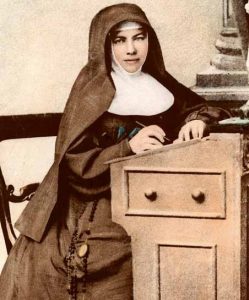 Mary and the early sisters used to beg to make ends meet. Throughout these stories of seeking out food, we see her compassion for the sick and the downtrodden. She shared the little they had and sometimes gave her own meal to someone in need. While Mary was a prolific writer, many of her companions left these stories for us by recounting the events that inspired them or humoured them. One such event is the arrival by Mary with a suckling pig to surprise Sr Patrick. Mary notes in her diary – Great amusement over poor piggy.
Mary and the early sisters used to beg to make ends meet. Throughout these stories of seeking out food, we see her compassion for the sick and the downtrodden. She shared the little they had and sometimes gave her own meal to someone in need. While Mary was a prolific writer, many of her companions left these stories for us by recounting the events that inspired them or humoured them. One such event is the arrival by Mary with a suckling pig to surprise Sr Patrick. Mary notes in her diary – Great amusement over poor piggy.
Mary was a progressive woman and even after she suffered a stroke, communication was an important part of her life. She acquired a typewriter and continued to connect with sisters and family. She continued sending spiritual and inspirational messages until the year of her death 1909. In January of that year she gives a heartfelt message to all of us “Do not be afraid. Love one another”. Her final words were a blessing – ‘God bless you all.”
We can only dream of what Mary would achieve if she enjoyed the technology that we are gifted with. We can see her speaking via Video or Webinar. Imagine the texts and the calls as well as the personal visits! However, gratefully and generously Mary utilized every possibility available to her, such was her insight into the power of the word and the necessity for connection and networking. We thank her for her amazing contribution to society and the congregation so dear to her heart.
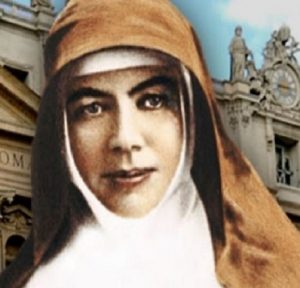 Reflection
Reflection
- Our current way of living offers a smorgasbord of technology. Mary MacKillop fostered personal connections in a limited way. How are we using our devices to remember our family members and friends particularly those suffering illness or hardship?
- Humour and surprise were important to Mary MacKillop. How can we bring joy to others in everyday life in simple ways?
- Let us be grateful for the gift of Mary.
Michele Shipperley rsj
Canonisation of St Mary MacKillop
October 17, 2020In Search of a Miracle.
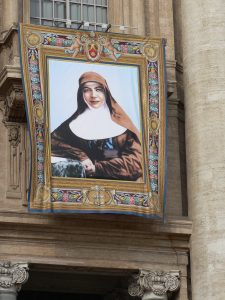 A significant requirement for a canonisation is the attribution of a miracle to the intercession of the person to be canonised. Saint Mary of the Cross was beatified by Pope John Paul II at Randwick Racecourse on 19 January, 1995. She was, by that proclamation, a saint for Australia. The next step was to seek her canonisation, a step that would recognise her as a saint for the universal church. This process required proof of her intercession by the recognition of another miracle which was needed to take place after the beatification.
A significant requirement for a canonisation is the attribution of a miracle to the intercession of the person to be canonised. Saint Mary of the Cross was beatified by Pope John Paul II at Randwick Racecourse on 19 January, 1995. She was, by that proclamation, a saint for Australia. The next step was to seek her canonisation, a step that would recognise her as a saint for the universal church. This process required proof of her intercession by the recognition of another miracle which was needed to take place after the beatification.
In 2001 I was appointed vice-postulator to Fr Paul Gardiner sj who was the Postulator since 1984. One of the tasks was to find a cure that would meet the stringent requirements to be considered for study as a miracle. Sr Claire Burgess and her assistants worked assiduously responding to requests for prayer for those in need. Claire had mountains of papers outlining remarkable cures but, for one reason or another, none met all the documentary requirements until one crossed her desk in 2005 relating to an extraordinary cure of Mrs Kathleen Evans. I visited Kath and her husband, Barry, at their home on 17 October, 2005. Barry as well as Kath’s doctors had kept copies of her medical records and were willing to share them. They were invaluable to the study for the miracle.
After my visit to Kath and Barry I wondered why I had not seen this case before. I was in bed and had a lightbulb moment – I realised that the cure had occurred after the Decree of Beatification was promulgated but before the ceremony was held. I got out of bed and called an official, Monsignor Robert Sarno, whom we had met some years previously as students from Ottawa visiting the Causes of Saints Dicastery. He informed me that the Bishop of Maitland – Newcastle was the person to write to the Prefect of the Causes of Saints asking for a dispensation of time. I drafted the letter which was duly sent by the Bishop early November and we looked forward to a good Christmas gift – the granting of the requested dispensation. It had not arrived by November 2007.
Mary MacKillop was a great believer in the Providence of God and Providence played a big part in the journey to canonisation. On 7 November, 2007 I was asked to attend lunch at Mary MacKillop Place with a group of overseas reporters preparing for World Youth Day 2008. One of the reporters asked how the Cause was progressing. I told him in rather strong terms of our disappointment with the non-reply from Rome to the request. When I finished, he informed me he was a close friend of the Prefect and he would visit him on his return. I was a bit mortified to say the least but thrilled (as were all who were waiting) to receive news of the requested dispensation in January 2008.
Thus, began the final two-year journey, a journey that had begun in 1925 when the Cause of Mary’s canonisation opened. Kathleen’s cure was declared a miracle through the intercession of Mary on 19 December, 2009. Mary of the Cross MacKillop was canonised in Rome, the first canonised saint for Australia and a saint for the universal Church, on 17 October, 2010 exactly five years to the day from my first meeting with Kathleen Evans. Kathleen (with Barry at her side) engaged in a wonderful ministry of making Mary MacKillop known and enjoyed good health for 23 more years – a wonderful miracle indeed.
Sr Maria Casey rsj
Associates to Companions – A New Chapter
As Mary MacKillop continues to inspire people today, the Associate movement which began over thirty years ago, is now one of the four recognised pathways of sharing in the Josephite charism.
Today the movement has ‘taken fresh courage’ and steps forward into the future with a new name – ‘Josephite Companions’.
Please join us in the launch of this new name, logo and prayer by viewing the following video…
Mary MacKillop’s Words of Wisdom
October 16, 2020Mary MacKillop’s words of wisdom – Take Fresh Courage.
Greetings on this 10th Anniversary of the canonisation of Mary MacKillop. Our hearts are filled with joy when we remember the excitement and gift of this day in 2010. Australians, Sisters from across the Congregation and the people with whom we had ministered were filled with great pride as we celebrated this special moment in our story.
Let us pause and remember that moment when Mary MacKillop was acclaimed as a saint of the universal church. Do you remember where you were and how you felt. My heart was filled with joy.
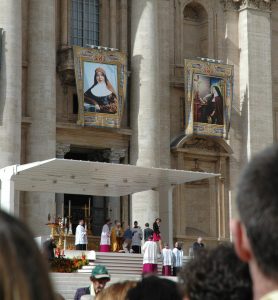 Let us take a moment’s silence and reflect on how the spirit of St Mary of the Cross MacKillop has continued to live on in each one since her canonisation. How has each one been gifted? How has her life continued to shape my commitment to living the Gospel way of life and to making a difference in the world?
Let us take a moment’s silence and reflect on how the spirit of St Mary of the Cross MacKillop has continued to live on in each one since her canonisation. How has each one been gifted? How has her life continued to shape my commitment to living the Gospel way of life and to making a difference in the world?
As we celebrate on this 10th anniversary, we recall that one of her marks of holiness was her capacity to persevere in the face of adversity. She teaches us to search for the seed of opportunity in every difficulty. In 1877 Mary MacKillop wrote a letter to her Sisters in a time when their very existence was being threatened. Her ever reassuring presence encouraged her Sisters to lean into the heart of God and to ‘Take Fresh Courage’.
Mary MacKillop’s life continues to speak to the realities of our lives. COVID-19 has turned our lives upside down in a variety of ways. It has called upon all our strength and resilience to ‘Take Fresh Courage’ as we find new ways of living with hope in a chaotic world.
As we celebrate this moment, may St Mary of the Cross MacKillop wrap her love around our hearts whispering to us to ‘Take Fresh Courage’.
As we remember with gratitude this special day, may we treasure the memories and rejoice in her continued blessing for our church and our world.
We thank God for the life, wisdom and continued contribution of St Mary of the Cross to Australia and our world.
Happy celebration.
Sr Monica Cavanagh
Congregational Leader
You’re invited to view Sr Monica’s video message below…
Josephite Associates become Josephite Companions
October 15, 2020A New Chapter for Josephite Associates.
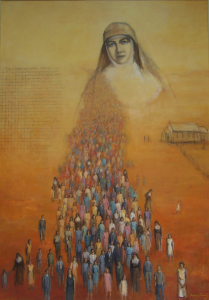
On this tenth anniversary of the canonisation of Saint Mary MacKillop, we also celebrate a milestone in the life of those women and men who are drawn to give expression to living the Gospel with a Josephite heart.
Formerly known as Josephite Associates, the Josephite Companions will launch their new name together with a new logo on Saturday 17 October 2020. In association with the Sisters of Saint Joseph of the Sacred Heart, Josephite Companions embrace the Josephite charism as they live the Gospel in their daily lives.
The Josephite Associates Movement (now Companions), stemmed from the teaching of the second Vatican Council with its vision of Church and community. Josephite Companions are women and men from all walks of life who are drawn to the spirit of St Mary MacKillop and Julian Tenison Woods and who are active in ministry in Australia, Aotearoa New Zealand, Peru, Timor-Leste and Scotland.
Josephite Companions participate in the life and mission of the Church by living out the Josephite charism through friendship, prayer and service. They firmly believe that “doing the ordinary with a Josephite heart” is a way of enriching their own lives as well as the lives of others.
Together with their new name and newly designed logo, new resources including a Companions’ Prayer and a “Discovery Program” have also been developed. All of which are for anyone wishing to explore the idea of becoming a Josephite Companion.
Josephite Companions rejoice in going forward and living life in the spirit of St Mary MacKillop as they continue God’s mission in an evolving world.
The link to the new Josephite Companions section and their launch video will be available on the Sisters of Saint Joseph website from Saturday 17 October 2020.
Media Release: Celebrating the 10th anniversary of Saint Mary MacKillop’s canonisation
Sydney, 12 October 2020: This Saturday 17 October 2020 will mark the 10th anniversary of Saint Mary MacKillop’s canonisation at Saint Peter’s Basilica in Rome, declaring her Australia’s first canonised saint.
Pope Benedict XVI addressed tens of thousands gathered in St Peter’s Square. About 9000 Australians travelled to celebrate this occasion.
For Catholic, Christian and secular Australians, it was a meaningful moment, celebrating the values at the heart of what it means to be Australian, as well as her witness to the sacred in everyday life. Ten years on, the Sisters of Saint Joseph invite the Australian community to take this opportunity to reflect on what the canonisation of Saint Mary MacKillop meant to Australians then, and what it means to us now.
To celebrate the 10th anniversary of the canonisation of Saint Mary MacKillop and the wonderful life and legacy she left behind, the Sisters of Saint Joseph of the Sacred Heart are pleased to remember her with commemorative prayers, videos, and a global vigil in her honour.
Inspiring all Australians to take courage and maintain hope as Mary did throughout her life, the theme chosen for this celebration is ‘Take Fresh Courage’. This theme chosen against the backdrop of the many challenges Australians have faced in 2020 is taken from a letter written by St Mary MacKillop in 1877.
On 16 October 2020 at 8pm AEST, the Sisters of Saint Joseph will hold Courage Hour, a global vigil of deep peace, prayer, and reflection. The Sisters invite all who may wish to participate to join the Vigil online www.sosj.org.au/10th-anniversary and celebrate Mary’s life and follow her lead to ‘Take Fresh Courage’…
Please continue reading the Media Release here (PDF)
For more information, please contact:
Kathleen Norman
Communications Manager
Sisters of Saint Joseph
Kathleen.Norman@sosj.org.au
+61 2 8912 2722 +61 438 006 566
Join us for Courage Hour
October 14, 2020Join us for a global Vigil to celebrate the 10th anniversary of Mary’s canonisation.
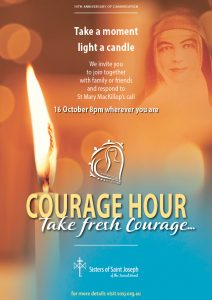 The Sisters of Saint Joseph of the Sacred Heart invite you to join us for a global Vigil of deep peace, prayer and reflection to celebrate the 10th anniversary of Saint Mary MacKillop’s canonisation.
The Sisters of Saint Joseph of the Sacred Heart invite you to join us for a global Vigil of deep peace, prayer and reflection to celebrate the 10th anniversary of Saint Mary MacKillop’s canonisation.
This Vigil invites us to come to peace and prayer and wrap our world in courage, that same courage from which Saint Mary MacKillop lived her life. Together let us ‘Take Fresh Courage’ for ourselves and for our world.
You may pray this Vigil alone; in a face-to-face group or perhaps join the online Guided Reflection.
The Sisters of Saint Joseph will be providing a scripted video resource that you can use for the online Guided Reflection, which is something that can be played at any time. The script for Courage Hour is also available in the Encountering St Mary MacKillop in Prayer booklet starting at page 26 available in English, Spanish and Italian on the webpage below.
Please note, the online Guided Reflection is not live and does not require you to register.
This Vigil will take place on Friday 16 October at 8:00pm your local time.
To view the video and Encountering St Mary MacKillop in Prayer booklet, visit the webpage provided below:
Celebrating Mary’s Canonisation
Together, we can all follow Mary’s lead and #TakeFreshCourage.
